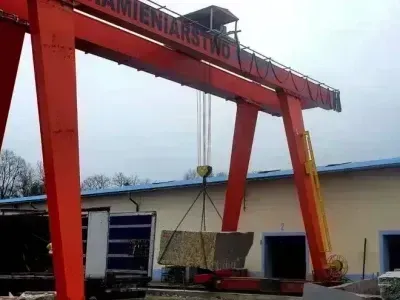- Feb 25, 2025
- News
How does the pulley system work in a crane?
Crane sheave systems use pulleys, cables and ropes to distribute weight across multiple sections of rope, allowing the crane to lift heavy loads with less force.
If you've ever watched a crane at work, you've noticed that cranes can smoothly lift dozens or even hundreds of tons. Are you curious how these machines lift such heavy loads? One of the key components is the crane pulley system.
What's a Pulley?

Before we get into how cranes use pulleys, let's start with the basics. A pulley is just a wheel with a groove around its edge where a rope or cable sits. When you pull on one end of the rope, the wheel spins, and whatever's attached to the other end—like a load—moves. Pretty straightforward, right? On its own, a single pulley doesn't make lifting any easier in terms of force; it just lets you change the direction you're pulling. So, instead of hauling something straight up, you can pull down or sideways, which can be more comfortable or practical depending on the setup.
In cranes, though, pulleys don't work solo. They team up in a system that does a lot more than just redirect force—it actually reduces the effort needed to lift heavy stuff.
How Crane Pulley Systems Actually Work
Cranes rely on what's called a block and tackle system, a setup that combines multiple pulleys to share the load and make lifting easier. Here's how it comes together:
- Two Sets of Pulleys: You've got one set of pulleys fixed to the crane's structure (called the fixed block) and another set attached to the load itself (the movable block).
- Rope Threading: A rope or cable runs back and forth between these two blocks, weaving through the pulleys to create several strands of rope supporting the load.
- Load Sharing: Each strand of rope takes on a portion of the weight. So, if you've got four strands, each one only carries a quarter of the total load, cutting down the force you need to apply.
Think of it like this: if you're trying to lift a 400-pound steel beam with a system that has four strands, you'd only need to pull with about 100 pounds of force. The pulleys spread the work out, making the job way more manageable. That's the essence of how cranes lift heavy loads without breaking a sweat—or, well, without overloading the machinery.
Components of a Crane Pulley System
A typical crane pulley system consists of several key components working together:
- Sheaves: These are the grooved wheels that the wire rope or cable runs over. Crane sheaves are typically made of hardened steel or cast iron and are designed to be durable and minimize wear on the rope. They come in various sizes and configurations depending on the rope diameter and load requirements. The crane sheave material and design are crucial for smooth and efficient rope movement.
- Wire Rope (or Cable): The high-strength steel rope that transmits the lifting force through the pulley system. Crane wire rope is specially constructed with multiple strands and wires to provide flexibility, strength, and resistance to wear and fatigue. The crane cable or rope diameter and construction are carefully selected based on the crane's load capacity and safety factors.
- Hook Block (or Lower Block): The assembly at the bottom of the hoist ropes that contains the lower set of pulleys and the hook for attaching to the load. The crane hook block is a heavy-duty component designed to withstand the full load and often includes features like safety latches to prevent accidental load slippage.
- Drum (or Hoist Drum): The large, grooved cylinder around which the wire rope is wound and unwound. The crane drum is driven by the hoist motor and gearbox, controlling the vertical movement of the rope and the load. The drum diameter and groove design are matched to the rope size and reeving configuration.
- Rope Guides (or Wire Rope Guides): Mechanisms that ensure the wire rope winds smoothly and evenly onto the drum, preventing overlapping, kinking, and damage to the rope. Crane rope guides are especially important in multi-layer drum winding to maintain rope integrity and prevent uneven wear.
Types of Pulleys in Cranes
Not all pulleys are the same, and cranes use a few different types depending on what they're built to do. Here's a quick rundown:
- Fixed Pulleys: These are bolted onto the crane's frame and don't move. Their main job is to change the direction of the rope—handy for pulling from a different angle, like downward instead of upward.
- Movable Pulleys: These are hooked to the load and shift as it moves. They're the ones that start giving you that force-reducing boost by sharing the weight across multiple rope strands.
- Compound Pulleys: This is when you mix fixed and movable pulleys together for a double whammy—changing direction and cutting down the effort needed. You'll see these in cranes tackling really hefty loads, like the ones used to build skyscrapers.
The materials matter too. Crane pulleys are usually made from tough stuff like steel or cast iron to handle the strain. The grooves are custom-fit to the rope or cable to keep everything running smoothly without slipping.
Conclusion
The pulley system of a crane consists mainly of wheels, ropes, and other components that work in tandem. With this design, the weight of the load will be spread out in such a way that it can lift heavy objects. As an important component of a crane, understanding the sheave system can help you gain a better understanding of crane operation.





